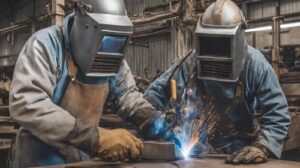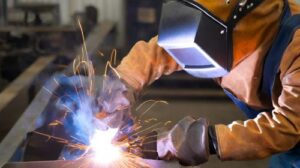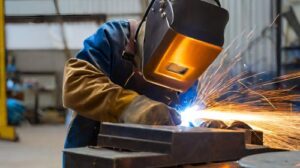Table of Contents
- The Basics: Understanding the Welding Process
- The Strength Spectrum: Factors Influencing Weld Strength
- Unveiling the Mystery: How Strong Are Welds?
- Challenges in Achieving Strong Welds
- Future Trends in Welding
- Case Studies: Examples of Strong Welds in Action
- Tips for Ensuring Strong Welds
- Conclusion
- FAQs
Have you ever wondered about the hidden strength behind those tiny, fiery sparks that welders create? Welding, often considered an art form by some and a practical necessity by others, is a process that joins materials, and the strength of the welds is crucial for ensuring the integrity of the final product.
So, just how strong are welds, and what factors influence their strength? Let’s dive into the world of welding and unveil the power behind the sparks!
The Basics: Understanding the Welding Process
Before we unravel the strength of welds, let’s take a quick look at the nuts and bolts of the welding process. Welding is a technique that involves melting materials, typically metals, and then allowing them to cool and fuse. This process requires precision, skill, and the right equipment.
1. The Welding Dance: Types of Welding Techniques
- Arc Welding: The classic method where an electric arc is created between an electrode and the materials being welded. Think of it as a fiery dance between metal and electricity!
- MIG Welding (Metal Inert Gas): A semi-automatic process using a wire electrode and inert gas, creating a clean and efficient weld. It’s like the Tesla of welding – high-tech and efficient!
- TIG Welding (Tungsten Inert Gas): Precision welding using a non-consumable tungsten electrode. TIG welding is like the surgeon of the welding world – delicate and precise.
2. Sparks Fly: What Happens During Welding?
As a welder works their magic, sparks fly, and materials become molten, forming a pool of liquid metal. This molten pool cools and solidifies, creating a strong bond between the materials. The strength of this bond is what determines how strong welds are in the end.
The Strength Spectrum: Factors Influencing Weld Strength
Now that we’ve got the basics down let’s dig into the factors that influence the strength of welds. It’s not just about the sparks; it’s about the science and finesse behind the entire process!
1. Material Matters
- Type of Metal: Different metals have varying properties, and their compatibility affects the strength of the weld. Mixing metals is like trying to make a gourmet dish with mismatched ingredients – it might not turn out as expected!
- Thickness: The thickness of the materials being welded plays a crucial role. Thicker materials might require more heat and penetration, while thinner ones demand finesse to avoid burn-through.
2. Welding Conditions
- Cleanliness: A clean workspace is critical to a strong weld. Dirt, rust, or contaminants can weaken the weld, making it akin to building a house on a shaky foundation.
- Temperature and Humidity: The environmental conditions during welding matter. Extreme temperatures or high humidity can impact the cooling process, affecting the final strength of the weld.
3. Welding Technique
- The skill of the Welder: Just like a painter with a brush, the skill of the welder matters. Precise control of the welding equipment, proper technique, and experience contribute to the strength of the weld.
- Welding Parameters: Adjusting parameters like voltage, current, and travel speed is like tuning a musical instrument. Get it right, and you’ll produce a harmonious, strong weld.
Unveiling the Mystery: How Strong Are Welds?
Now that we’ve explored the factors influencing weld strength, let’s answer the burning question: How strong are welds, really?
1. Tearing it Down: Weld Strength Testing
- Tensile Strength Test: This test pulls the welded materials apart to measure the force required. It’s like checking if your backpack can handle the weight of all those textbooks!
- Bend Test: The weld undergoes a bending process to check its flexibility and resilience. It’s the limbo dance of welding – how low can you go without breaking?
2. The Numbers Game: Understanding Weld Strength Metrics
- Welding Standards: Various standards and codes exist to ensure weld quality and strength. Meeting these standards is like getting a stamp of approval from the welding gods!
- Welding Symbols: Understanding the symbols on welding blueprints is crucial. It’s like decoding a secret language that tells you how strong a weld should be for a specific application.
Challenges in Achieving Strong Welds
Compatibility Issues
Material Compatibility: One of the primary challenges in achieving strong welds is dealing with material compatibility issues. Welding involves joining different materials, and if these materials are not compatible, it can lead to weakened welds.
Mismatched materials may have varying thermal expansion rates or incompatible compositions, resulting in difficulties in achieving a robust and durable weld. Careful consideration of material compatibility is crucial to overcome this challenge and ensure the strength of the weld.
Welding Technique Compatibility: Compatibility extends beyond just materials; it also involves the compatibility of welding techniques. Certain welding methods may be more suitable for specific materials or applications.
Ensuring that the chosen welding technique aligns with the characteristics of the materials being joined is essential to overcoming compatibility challenges and achieving strong welds.
Design Complexity
Complex Geometries: Design complexity poses another significant challenge in the quest for strong welds. Welding intricate or complex geometries requires careful planning and execution. Welders must navigate through complicated joint configurations, which can be time-consuming and may demand advanced welding skills.
Overcoming the challenges associated with complex designs involves collaboration between designers and welders to find solutions that maintain the strength and integrity of the welds.
Joint Accessibility: In complex designs, reaching certain joints for welding can be challenging. Limited accessibility may hinder the welder’s ability to achieve optimal penetration and fusion.
Addressing this challenge involves creative solutions in fixture design or the use of specialized welding equipment to ensure that even hard-to-reach joints receive the attention required for strong welds.
Successfully tackling compatibility issues and design complexities demands a combination of expertise, careful planning, and innovative problem-solving.
By addressing these challenges head-on, welders can enhance their ability to produce strong and reliable welds, contributing to the overall quality and longevity of welded structures.
Future Trends in Welding
Automation in Welding
Robotic Welding Systems: One of the prominent future trends in welding is the increasing integration of automation. Automated welding systems are becoming more prevalent, offering precise and efficient welding capabilities. These systems utilize advanced sensors and programming to perform welding tasks with high accuracy.
Automation not only enhances the speed of the welding process but also contributes to consistent and reliable weld quality. As technology continues to evolve, the adoption of robotic welding is expected to grow, transforming the landscape of welding industries.
Artificial Intelligence (AI) in Welding: The future of welding involves the incorporation of artificial intelligence. AI algorithms can analyze data from various sensors in real time, adjusting welding parameters dynamically. This level of adaptability ensures optimal weld quality under varying conditions.
AI-driven welding systems have the potential to revolutionize the industry by providing adaptive and intelligent welding solutions, improving efficiency, and reducing the margin of error.
Advanced Materials
High-Strength Alloys: The use of advanced materials is a key trend shaping the future of welding. High-strength alloys, characterized by enhanced mechanical properties, are becoming more prevalent in various industries.
These alloys offer superior strength-to-weight ratios, making them ideal for applications where both strength and weight considerations are critical.
Welding technologies are evolving to accommodate these advanced materials, ensuring strong and reliable welds in structures and components composed of high-strength alloys.
Composite Materials: Another aspect of the future of welding involves the welding of composite materials. As industries explore lightweight and durable alternatives, welding techniques are adapting to join composite materials effectively.
Welding methods that cater to the specific characteristics of composites, such as fibre-reinforced polymers, are emerging. The ability to weld composite materials opens new possibilities for industries seeking innovative solutions for various applications.
The future trends in welding, characterized by automation and the use of advanced materials, represent a paradigm shift in the industry.
These trends not only streamline the welding process but also introduce new possibilities for materials and applications. As technology continues to advance, the welding field is poised for exciting developments that will further enhance the efficiency, precision, and strength of welds.
Case Studies: Examples of Strong Welds in Action
Bridges
Bridges stand as shining examples of the importance of strong welds. When constructing bridges, welds play a vital role in ensuring the structural integrity and safety of these colossal structures. Engineers meticulously plan and execute welds to join steel beams, reinforcing the bridge’s framework.
Case studies of successful bridge construction reveal the significance of strong welds in bearing the weight and stresses imposed by vehicular and pedestrian traffic. The durability of these welds directly contributes to the longevity and reliability of the entire bridge infrastructure.
Pressure Vessels
In various industries, pressure vessels are used to contain liquids or gases under high pressure. The reliability of these vessels hinges on the strength of the welds.
Case studies in the manufacturing of pressure vessels highlight how precise and robust welds are essential for preventing leaks and ensuring the safety of the contained substances.
Strong welds in pressure vessels are a critical factor in preventing catastrophic failures and potential hazards, emphasizing the importance of quality welding in industrial applications.
High-Performance Vehicles
When it comes to high-performance vehicles, such as sports cars or specialized vehicles used in racing, the role of strong welds cannot be overstated. These vehicles undergo intense stresses and forces, especially during high-speed manoeuvres.
Case studies in the automotive industry showcase how well-executed welds contribute to the structural integrity of these vehicles.
Strong welds in the chassis and other components not only enhance the safety of the occupants but also play a crucial role in achieving optimal performance. The ability of welds to withstand dynamic forces is a testament to their strength in action.
In each of these case studies, the common thread is the reliance on strong welds to ensure the safety, durability, and performance of structures and vehicles. The success stories of bridges, pressure vessels, and high-performance cars underscore the pivotal role of welding in diverse applications, showcasing the real-world impact of robust welds in action.
Tips for Ensuring Strong Welds
Adequate Preparation
Thorough Cleaning: Before initiating the welding process, ensure that the surfaces to be welded are thoroughly cleaned. Any contaminants, such as rust, dirt, or oil, can compromise the quality of the weld. Use appropriate cleaning methods and solvents to achieve a clean and smooth surface for welding.
Proper Joint Fit-Up: A crucial aspect of welding is ensuring proper joint fit-up. The alignment and fit of the materials to be welded directly impact the strength of the final weld. Take the time to prepare and fit the joints accurately, minimizing gaps and ensuring a snug fit for optimal welding results.
Material Compatibility: Consider the compatibility of the materials being welded. Ensure that the base metals are compatible in terms of composition and mechanical properties. Mismatched materials can lead to weak welds, emphasizing the importance of selecting compatible materials for a robust bond.
Quality Control Measures
Regular Inspections: Implement regular inspections throughout the welding process. Periodic checks enable early detection of any issues or defects, allowing for timely corrections. Inspect welds visually and, if necessary, use non-destructive testing methods to ensure the weld’s integrity.
Adherence to Standards: Follow established welding standards and guidelines, such as those provided by organizations like the American Welding Society (AWS) or the International Organization for Standardization (ISO). Adhering to industry standards ensures that the welding process meets recognized benchmarks for quality and strength.
Welding Parameters: Pay close attention to welding parameters, including voltage, current, and travel speed. Adjust these parameters based on the specific requirements of the materials and welding technique being employed. Fine-tuning the welding parameters contributes to achieving solid and reliable welds.
By focusing on adequate preparation and incorporating stringent quality control measures, welders can significantly enhance the strength and reliability of their welds. These tips underscore the importance of attention to detail and adherence to best practices in the pursuit of consistently strong welds.
Conclusion
So, how strong are welds? The strength of a weld is a delicate balance influenced by the type of metal, welding conditions, and the skill of the welder. It’s not just about creating sparks; it’s about mastering the art and science of joining materials.
Whether you’re a seasoned welder or just someone fascinated by the fiery dance of welding, understanding the strength behind those sparks adds a new layer to the craft. So, the next time you see a weld, appreciate the strength hidden within – it’s the unsung hero holding things together!
FAQs
What factors influence the strength of welds?
Material selection, welding technique, and environmental conditions are key factors influencing weld strength.
How are welds tested for strength?
Welds can be tested through non-destructive methods like ultrasonic testing or destructive methods that involve physically testing a sample weld.
Why is the role of skilled welders important?
Skilled welders are crucial for achieving strong welds ensuring proper material selection, technique, and adherence to standards.
How do strong welds contribute to environmental sustainability?
Adopting sustainable practices and recycling welding materials help minimize the environmental impact of welding processes.
What Happens if a Weld Isn’t Strong Enough?
Weak welds can result in structural failures, which is like building a bridge with toothpicks. It might hold for a while, but disaster is inevitable.



